Travel Through Iran on a Harley-Davidson
By Peter & Kay Forwood
Iran on a Harley (24/11/06 - 5/12/06)
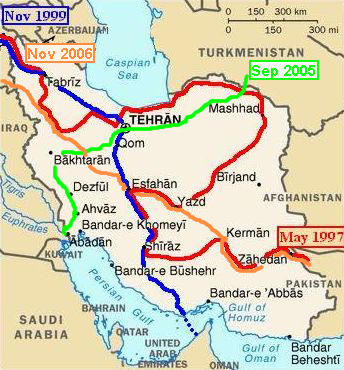
Distance 2520 km (480647 km to 483167
km)
This is part of the twelfth section of our around the
world trip.
Complete Trip Overview & Map
Coming from Turkey or read our
previous visit to Iran
24/11/06 The border post is right on the border. There is hardly spitting
distance between Iran's and Turkey's formalities. We were well received. Kay
had bought an abeyya (all encompassing cloak) and head scarf for the occasion,
a requirement for women visiting Iran, and was now wearing it. A few questions,
where were we going and why, a thorough inspection of the passports and carnet
but no inspection of our luggage. This was also the case on my last visit,
last year, and after less than 30 minutes we were riding on better quality
roads but with much more traffic. Knowing petrol was cheap here, we had only
a few km's in reserve, and filled up at 4% of the price we had been paying
in Turkey, Less than 9 cents a litre instead of almost $US 2.00 a litre.
Being government owned, and with the national pastime of driving, petrol
stations are a bit scarce and short lines develop at most of them. The day
did not warm, nor did the snow disappear from the roadside and surrounding
hills. We travelled 250 km's to Saqqez, along the road to Sanandaj. Saqqez
is our stop only because it has a hotel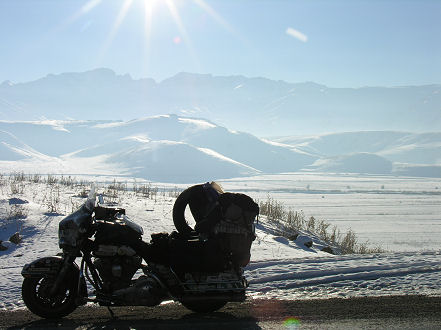 and we had slowly been getting colder as the day progressed.
Fog was settling in, blocking out the sun. Whilst buying petrol we asked
a taxi driver if we could follow him to a hotel as most Iranian cities are
traffic filled and spread out with few hotels, whilst taxi's are cheap.
and we had slowly been getting colder as the day progressed.
Fog was settling in, blocking out the sun. Whilst buying petrol we asked
a taxi driver if we could follow him to a hotel as most Iranian cities are
traffic filled and spread out with few hotels, whilst taxi's are cheap.
25/11/06 With petrol prices so low there is no need to burn wood or
coal so the air here is clearer and more breathable. Another early start
trying to get beyond the mountains, and out of the snow that still
surrounded us, but not today. We travelled 350 km to Hamadan, left
with the white stuff and arrived the same. This is a great mountain
plateau and whilst we descended to Sanandaj in sunshine another pass
brought us back onto a higher plateau with bitter cold. Even after midday
the frost hung from bushes and trees whilst in weak sunshine the ploughed
fields were covered in rising mist, creating small whirlwinds of rising
fog. We are wearing everything. Three layers of socks, thermals, track
pants, windproof rain pants, five layers of shirts and jackets, and we still
need to stop every hour to warm up at one of the many small heated truck
restaurants. We are well received, even though Kay is the only woman. Viewed
a little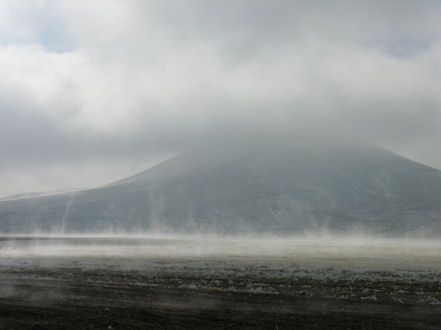 as crazy westerners riding a motorcycle, however there are many
local motorcycles still on the roads here. We had ordered heated jackets
and gloves when we decided to ride through this region at this time
of the year but due to a change in Harley-Davidson's policy of
discontinuing local distributors in Australia and taking on the role
themselves it took five weeks for the goods to get from the USA to Australia.
That combined with us moving quicker than expected meant it was too late
to have them air freighted to us. Although this delay might be teething
problems it does not give us confidence for taking home the engine top
end, from India, to be rebuilt, if parts are going to take five weeks to
arrive, we will only be in Australia for four weeks. The dealer, Morgan
and Wacker of Brisbane, who arranges our parts, is as frustrated as
us over the delays.
as crazy westerners riding a motorcycle, however there are many
local motorcycles still on the roads here. We had ordered heated jackets
and gloves when we decided to ride through this region at this time
of the year but due to a change in Harley-Davidson's policy of
discontinuing local distributors in Australia and taking on the role
themselves it took five weeks for the goods to get from the USA to Australia.
That combined with us moving quicker than expected meant it was too late
to have them air freighted to us. Although this delay might be teething
problems it does not give us confidence for taking home the engine top
end, from India, to be rebuilt, if parts are going to take five weeks to
arrive, we will only be in Australia for four weeks. The dealer, Morgan
and Wacker of Brisbane, who arranges our parts, is as frustrated as
us over the delays.
26/11/06 Awoke to another frozen morning. Every 50 km's a couple
of crazy Australians could be seen jumping up and down or running on the
spot next to their motorcycle trying to get the circulation back into feet
and hands. The road slowly moved down off the plateau and the snow disappeared
from the roadside but not before a last flurry was sent to remind us.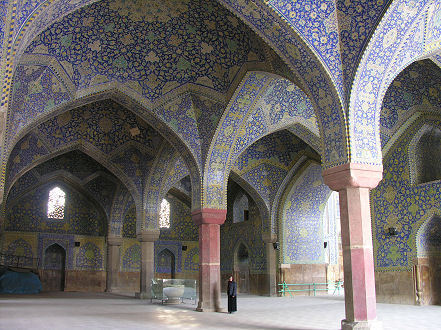 It was 500 km into Esfahan, where we hope the weather will be warmer.
Iran has changed quite markedly from my first visit in 1997 to this fourth
visit. The most noticeable change is the amount of consumerism, but also
the individual wealth of the people, and the more liberal personal
appearance of dress, style and face makeup. The hospitality shown to strangers
hasn't changed and is still amongst the friendliest we have encountered.
Shops are full of products. We see mostly clothes as the current display
of personality. Younger women, even in remote cities, wear plain coloured
coats, well above the knee, revealing slacks, the occasional ankle is bared
beneath. The compulsory head scarf is sometimes behind the crown of the head
with a fashionable hat on top. Even the older ladies have shortened their
cloaks which rarely drag on the ground anymore. A slow change in ten years
compared to the 1970's revolutions which within a couple of years brought
mini skirts and hot pants to the west. In many ways Iran is more liberal than
most strict Muslim nations. The women are seen in the streets in equal numbers
to men, often alone, occasionally a few with a young male friend. We are
told that the religious police are still about, checking to see that lone
couples are married, and suitably dressed. Men are also
It was 500 km into Esfahan, where we hope the weather will be warmer.
Iran has changed quite markedly from my first visit in 1997 to this fourth
visit. The most noticeable change is the amount of consumerism, but also
the individual wealth of the people, and the more liberal personal
appearance of dress, style and face makeup. The hospitality shown to strangers
hasn't changed and is still amongst the friendliest we have encountered.
Shops are full of products. We see mostly clothes as the current display
of personality. Younger women, even in remote cities, wear plain coloured
coats, well above the knee, revealing slacks, the occasional ankle is bared
beneath. The compulsory head scarf is sometimes behind the crown of the head
with a fashionable hat on top. Even the older ladies have shortened their
cloaks which rarely drag on the ground anymore. A slow change in ten years
compared to the 1970's revolutions which within a couple of years brought
mini skirts and hot pants to the west. In many ways Iran is more liberal than
most strict Muslim nations. The women are seen in the streets in equal numbers
to men, often alone, occasionally a few with a young male friend. We are
told that the religious police are still about, checking to see that lone
couples are married, and suitably dressed. Men are also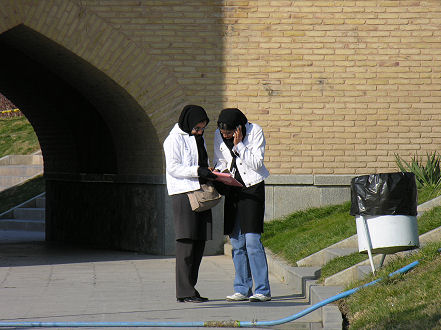 displaying their individuality more with varying hair length, sometimes
below the shoulder. Their dress could even be considered flashy at times.
displaying their individuality more with varying hair length, sometimes
below the shoulder. Their dress could even be considered flashy at times.
27/11/06 When I was at college in the early 1970's the Hillman Hunter
was a popular car and in Iran, the equivalent was still made here till
a couple of years ago. They have kept that popularity here, representing,
from a quick survey, 50% of cars on the road, the Iranian people's car.
The large American vehicles, from the days of the Shah in the late 1970's
have all but disappeared, from age, and a new breed of smaller cars have
replaced them. We enjoyed the late morning sleeping and the company of the
first travellers we have seen in a long time. Esfahan is probably the most
popular Iranian city for tourists and a place where overland travellers congregate.
We are about the last bunch heading south for the winter, almost no-one
is going north. A couple of bicyclists, another motorcyclist and half a
dozen bus travellers, all heading for Pakistan and India. It was reminiscent,
walking around the Imam Square, of Kay's and my visit here in 1998. A teahouse
tea overlooking the magnificent blue hue tiles of the Imam Mosque and the
Sheikh Lotfollah Mosque on the square. A quiet place in the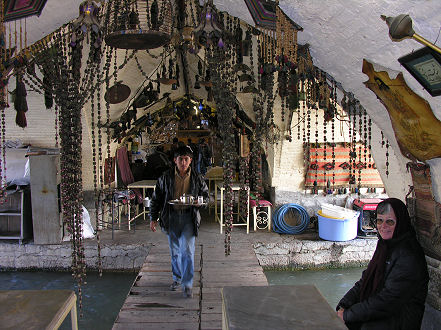 cool day devoid of the peak tourist season we could walk unhassled
and alone through the buildings.
cool day devoid of the peak tourist season we could walk unhassled
and alone through the buildings.
28/11/06 Pounding the pavement. Esfahan is probably Iran's most beautiful
city. The Zayandeh River flows through and is crossed by eleven bridges,
some dating back to the 12th century. We enjoyed tea beneath one. A male
only establishment, tourist women are allowed, but only inside, outside
is strictly for men. Couples were paddle boating downstream and a spread
of open park areas flanked the river. A treed, well watered place, making
strolling pleasant. Lunched at a traditional restaurant off Imam Square
and a walk through the old bazaar where old men live and work as they have
for centuries and mosques dot densely populated lane ways of mud and fired
brick homes.
29/11/06 The nights are still freezing but the days warm in sunshine.
We left for Yazd, just 320 km, more into the desert region. We don't recall
seeing any naturally growing trees and only a few planted ones outside
cities since entering Iran. One cold mountain pass had us again jumping
on the spot to increase our circulation but otherwise it was a lovely ride
past a mud brick caravanserai and some mud and brick walled villages. An
oil change,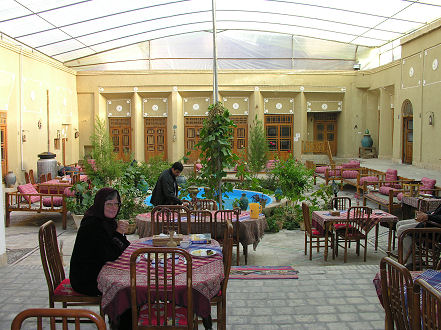 along the way, where prices matched the almost free petrol.
Yazd was just a quick overnight stop eight years ago for me in Iran but
having had good reports we have decided to stay here for three nights.
The Silk Road Hotel has become quite famous amongst travellers. In the
middle of the old town, and situated near some historical mosques, it
is constructed of brick and mud. The rooms are tastefully modernised but
have local construction and design. The main courtyard is one story below
ground level but open to the sky with a windowless level in the cool basement.
A great meeting place. Again there are travellers by bicycle, but mostly
by bus. Japanese represent the majority, possibly the policy of easy visas
for Asians.
along the way, where prices matched the almost free petrol.
Yazd was just a quick overnight stop eight years ago for me in Iran but
having had good reports we have decided to stay here for three nights.
The Silk Road Hotel has become quite famous amongst travellers. In the
middle of the old town, and situated near some historical mosques, it
is constructed of brick and mud. The rooms are tastefully modernised but
have local construction and design. The main courtyard is one story below
ground level but open to the sky with a windowless level in the cool basement.
A great meeting place. Again there are travellers by bicycle, but mostly
by bus. Japanese represent the majority, possibly the policy of easy visas
for Asians.
30/11/06 The covered bazaar is the forerunner of the western shopping
mall and Yazd's has one of the largest and oldest, believed to be over
1000 years old. Brick arched pedestrian lane ways criss cross the city.
Small shops front each and getting lost in the labyrinth is half the fun.
Wind towers draw air across water to keep the inside cool in the summer heat
and being partially underground the temperatures remain pleasant, even in
winter. The sliced bread shaped, sundried brick that is used in almost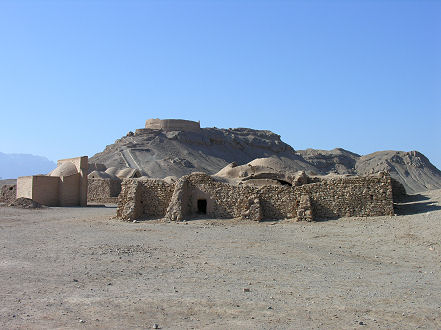 all Iranian construction, often covered with a mud and straw mix,
creates the walls and arched or domed roofs, forming many appealing ceiling
designs and patterns. We climbed to the top of the Imam Hossein Takieh,
a three story construction and the highest building in the city other than
the many minarets. Much is underground with only one mud brick story covering
the landscape of half a million people. As a mud house collapses, or is
beyond repair, a new dwelling is built on top of the old one creating many
layers of past history beneath. We also visited the Zoroastrian Fire Temple
where the sacred flame, that has burnt for over 1500 years, is now housed.
Zoroastrianism first started in Persia more than 500 years before Christ
and was the dominant religion before Islam. Until recently their dead were
left for the vultures to pick the bones clean at the Towers of Silence on
the outskirts of Yazd, which we visited today.
all Iranian construction, often covered with a mud and straw mix,
creates the walls and arched or domed roofs, forming many appealing ceiling
designs and patterns. We climbed to the top of the Imam Hossein Takieh,
a three story construction and the highest building in the city other than
the many minarets. Much is underground with only one mud brick story covering
the landscape of half a million people. As a mud house collapses, or is
beyond repair, a new dwelling is built on top of the old one creating many
layers of past history beneath. We also visited the Zoroastrian Fire Temple
where the sacred flame, that has burnt for over 1500 years, is now housed.
Zoroastrianism first started in Persia more than 500 years before Christ
and was the dominant religion before Islam. Until recently their dead were
left for the vultures to pick the bones clean at the Towers of Silence on
the outskirts of Yazd, which we visited today.
1/12/06 Hardly left the Silk Road Hotel all day. The greatest concentration
of travellers in the last 12 months. Eight nationalities relaxed in the
courtyard. A Friday, most things are closed and a day to plan the road
ahead. An Australian travelling in from Pakistan, the only person heading
wes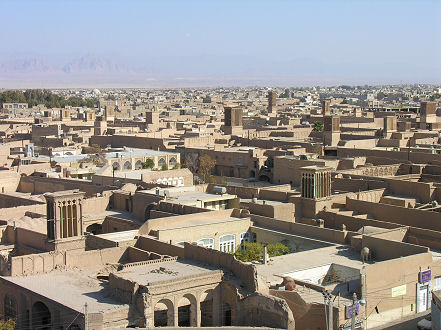 t, had the latest on that volatile country. The Pakistan Embassies
require a letter of introduction from most peoples embassy's to issue
visas. The French and German Governments have travel advisories against
travel in Pakistan and think it contradictory to then issue the letter,
so they are currently unable to obtain visas to travel overland. It appears
a free police escort is necessary from the Iranian border the 1200 km to
Multan via Quetta for people not travelling on public transport, bicyclists
must go by bus. The lone Japanese female motorcyclist we met in Esfahan,
is also here, and would like to travel Pakistan with us for better security.
The unknown ahead the main talking point of the congregating travellers.
t, had the latest on that volatile country. The Pakistan Embassies
require a letter of introduction from most peoples embassy's to issue
visas. The French and German Governments have travel advisories against
travel in Pakistan and think it contradictory to then issue the letter,
so they are currently unable to obtain visas to travel overland. It appears
a free police escort is necessary from the Iranian border the 1200 km to
Multan via Quetta for people not travelling on public transport, bicyclists
must go by bus. The lone Japanese female motorcyclist we met in Esfahan,
is also here, and would like to travel Pakistan with us for better security.
The unknown ahead the main talking point of the congregating travellers.
2/12/06 A Dutch bicyclist on his way to South America?, the long way
round, was pedalling in our direction. Living on just 3 Euro a day, escaping
the work drudgery of Europe, we chatted roadside for an hour, his first
encounter with westerners since leaving Istanbul two months ago as he has
been travelling the smaller back roads. It takes a certain type of person
to bicycle alone, with thousands of hours available for self reflection
time, individually against everything encountered. We rode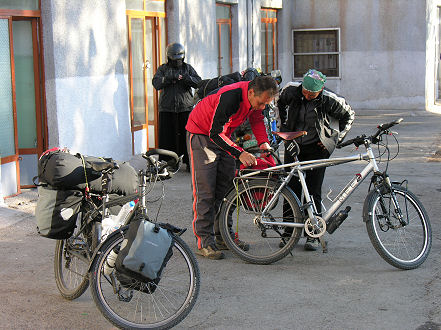 on to Kerman, 350 km's, just a stop over night, where two more, again
Dutch, bicyclists have been staying a couple of nights, also on their way
towards Pakistan. The roads are narrowing all travellers to just one, from
Kerman to Quetta in Pakistan there is no choice of a different path. Petra
and Wim, ex truck drivers, dissatisfied with the overpopulated and overregulated
Netherlands have headed off indefinitely. In this small world of coincidence,
Petra owns a Harley-Davidson and was at the 100th Anniversary in Milwaukee
in 2003 but also toured with Mike Ferris's Himalayan motorcycle tour in India,
the same organisation we are touring Bhutan with in February. It is rare
we meet a disgruntled bicyclist. The peace of the solitude either creates
a relaxed mentality or it is that type of person who is interested in cycling.
More often we find motorcyclists or motorcar drivers less comfortable with
their circumstances. There seems to be less expectations from bicyclists compared
to motorised travellers.
on to Kerman, 350 km's, just a stop over night, where two more, again
Dutch, bicyclists have been staying a couple of nights, also on their way
towards Pakistan. The roads are narrowing all travellers to just one, from
Kerman to Quetta in Pakistan there is no choice of a different path. Petra
and Wim, ex truck drivers, dissatisfied with the overpopulated and overregulated
Netherlands have headed off indefinitely. In this small world of coincidence,
Petra owns a Harley-Davidson and was at the 100th Anniversary in Milwaukee
in 2003 but also toured with Mike Ferris's Himalayan motorcycle tour in India,
the same organisation we are touring Bhutan with in February. It is rare
we meet a disgruntled bicyclist. The peace of the solitude either creates
a relaxed mentality or it is that type of person who is interested in cycling.
More often we find motorcyclists or motorcar drivers less comfortable with
their circumstances. There seems to be less expectations from bicyclists compared
to motorised travellers.
3/12/06 The road rises to over 2500 metres as it climbs out of Kerman
on a plateau between two mountain ranges. Mt. Hezar, Iran's highest, at
almost 4500 metres is surrounded by cloud and small beads of ice are falling,
blowing like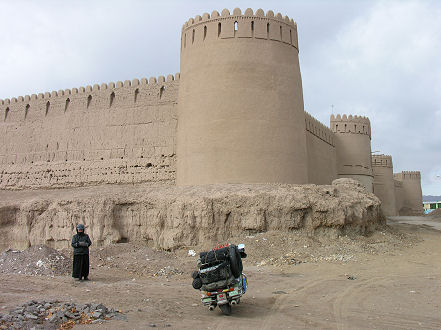 sand across the road. Rayen, a little off the main road, has a 1000 year
old citadel, a mud walled city. Not inhabited for the last 150 years it is
now being restored. The newer Rayen city, in the older parts has little difference
in building construction techniques and materials to the citadel. Mud and
sun dried bricks, domed rooves, still the preferred method. Restoration of
the citadel is partially completed and shows a good mix of the decay and
how the city would have looked with its massive exterior walls, opulent governor's
quarters and basic common people's houses. The last 70 km's into Bam is
down off the plateau, gradually warming, where we again met the two cyclists
from last night. It seems the snow on the mountain pass had increased later
in the day, they were advised not to ride, so hitchhiked a truck into Bam.
sand across the road. Rayen, a little off the main road, has a 1000 year
old citadel, a mud walled city. Not inhabited for the last 150 years it is
now being restored. The newer Rayen city, in the older parts has little difference
in building construction techniques and materials to the citadel. Mud and
sun dried bricks, domed rooves, still the preferred method. Restoration of
the citadel is partially completed and shows a good mix of the decay and
how the city would have looked with its massive exterior walls, opulent governor's
quarters and basic common people's houses. The last 70 km's into Bam is
down off the plateau, gradually warming, where we again met the two cyclists
from last night. It seems the snow on the mountain pass had increased later
in the day, they were advised not to ride, so hitchhiked a truck into Bam.
4/12/06 On my visit to Iran in 1998, the citadel, Arg-e-Bam, was
an amazing construction of mud. Having been situated along the trading route
from east to west it's had many famous visitors including Marco Polo in
it's 1200 year history. Unfortunately the earthquake that struck this region
just three years ago, killing over 30,000 people, almost completely destroyed
the complex. The restoration work, now well underway, is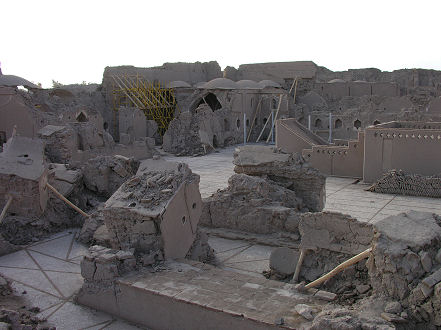 unlikely to be finished in my life time. The nondescript city of
Bam was also destroyed and now looks like a war zone reconstruction area.
There are few old buildings. Most new ones are not finished. Steel and
brick, the new earthquake proof materials, are being thrown up into dwellings
everywhere yet many people and businesses live and operate out of shipping
containers. A bustling city of hurrying people attempting to grab quick money,
with local and migrant workers vying for jobs it has taken on the feel of
a frontier gold rush mining town. We learnt later today that the road over
yesterday's pass was closed due to snow, as we rested in sunshine at our
hotel.
unlikely to be finished in my life time. The nondescript city of
Bam was also destroyed and now looks like a war zone reconstruction area.
There are few old buildings. Most new ones are not finished. Steel and
brick, the new earthquake proof materials, are being thrown up into dwellings
everywhere yet many people and businesses live and operate out of shipping
containers. A bustling city of hurrying people attempting to grab quick money,
with local and migrant workers vying for jobs it has taken on the feel of
a frontier gold rush mining town. We learnt later today that the road over
yesterday's pass was closed due to snow, as we rested in sunshine at our
hotel.
5/12/06 Miki (Minori), a Japanese woman, was planning a motorcycle
ride with her friend to the USA when the friend died in an accident. They
had not decided where they would visit in America, so to honour the remembrance
of her friend, Miki rode solo to all 50 states. She has since ridden across
Russia to Europe and is now finishing her third solo trip, this time from
South Africa to Nepal through some challenging countries for a woman on her
own. We first met her in Esfahan, decided to ride together from Bam to Quetta
in Pakistan and this morning left Bam early for the border. Miki is riding
a 250 cc dirt bike and travels at 80 to 90 km/hr and hasn't been stopping
except t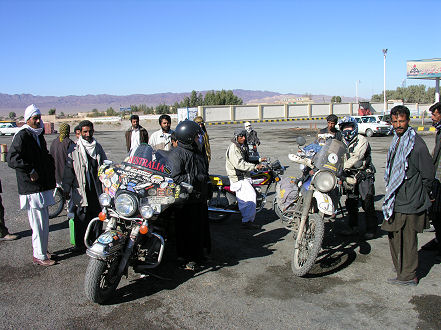 o refuel. Often refused entry to restaurants here as a lone woman
and receiving more attention from men than she likes she has been moving
from hotel to hotel with few stops. The 300 km to Zahedan was uneventful
other than seeing a horrendous accident between two trucks and three cars,
passing by soon after it had occurred, with one car still burning and a number
of people dead. The driving in Iran is usually fast and close, with vehicles
often passing us with centimetres to spare. Just one miscalculation, we
have seen many accidents. From Zahedan to the border, pickup trucks, carrying
smuggled goods from Pakistan filled the road. Pickup truck loads of plastic
drums of petrol have been heading into the desert, destined for Pakistan,
and creating a shortage of petrol near the border in Iran, but these other
pickups are in their hundreds, ferrying goods. In this lawless region tribal
chiefs, not the government, control most of what crosses borders. The official
border had almost no traffic, a couple of trucks, a few bus travellers and
us. The Bam hostel we were staying in for two nights had a steady stream
of Kenyan's moving through. Evasive to questions, when pressed they said
they were tourists. We didn't see any other Kenyan's or even dark skinned
people in Iran, and I hardly think Bam would be high on the list for Kenyan
tourists, perhaps also a result of a loose border. An easy crossing, one
hour, but as the time difference is 90 minutes between Iran and Pakistan we
needed to hurry to be assured of getting into Pakistan before they closed
at 5pm.
o refuel. Often refused entry to restaurants here as a lone woman
and receiving more attention from men than she likes she has been moving
from hotel to hotel with few stops. The 300 km to Zahedan was uneventful
other than seeing a horrendous accident between two trucks and three cars,
passing by soon after it had occurred, with one car still burning and a number
of people dead. The driving in Iran is usually fast and close, with vehicles
often passing us with centimetres to spare. Just one miscalculation, we
have seen many accidents. From Zahedan to the border, pickup trucks, carrying
smuggled goods from Pakistan filled the road. Pickup truck loads of plastic
drums of petrol have been heading into the desert, destined for Pakistan,
and creating a shortage of petrol near the border in Iran, but these other
pickups are in their hundreds, ferrying goods. In this lawless region tribal
chiefs, not the government, control most of what crosses borders. The official
border had almost no traffic, a couple of trucks, a few bus travellers and
us. The Bam hostel we were staying in for two nights had a steady stream
of Kenyan's moving through. Evasive to questions, when pressed they said
they were tourists. We didn't see any other Kenyan's or even dark skinned
people in Iran, and I hardly think Bam would be high on the list for Kenyan
tourists, perhaps also a result of a loose border. An easy crossing, one
hour, but as the time difference is 90 minutes between Iran and Pakistan we
needed to hurry to be assured of getting into Pakistan before they closed
at 5pm.
Move with us to Pakistan
 and we had slowly been getting colder as the day progressed.
Fog was settling in, blocking out the sun. Whilst buying petrol we asked
a taxi driver if we could follow him to a hotel as most Iranian cities are
traffic filled and spread out with few hotels, whilst taxi's are cheap.
and we had slowly been getting colder as the day progressed.
Fog was settling in, blocking out the sun. Whilst buying petrol we asked
a taxi driver if we could follow him to a hotel as most Iranian cities are
traffic filled and spread out with few hotels, whilst taxi's are cheap.
 as crazy westerners riding a motorcycle, however there are many
local motorcycles still on the roads here. We had ordered heated jackets
and gloves when we decided to ride through this region at this time
of the year but due to a change in Harley-Davidson's policy of
discontinuing local distributors in Australia and taking on the role
themselves it took five weeks for the goods to get from the USA to Australia.
That combined with us moving quicker than expected meant it was too late
to have them air freighted to us. Although this delay might be teething
problems it does not give us confidence for taking home the engine top
end, from India, to be rebuilt, if parts are going to take five weeks to
arrive, we will only be in Australia for four weeks. The dealer, Morgan
and Wacker of Brisbane, who arranges our parts, is as frustrated as
us over the delays.
as crazy westerners riding a motorcycle, however there are many
local motorcycles still on the roads here. We had ordered heated jackets
and gloves when we decided to ride through this region at this time
of the year but due to a change in Harley-Davidson's policy of
discontinuing local distributors in Australia and taking on the role
themselves it took five weeks for the goods to get from the USA to Australia.
That combined with us moving quicker than expected meant it was too late
to have them air freighted to us. Although this delay might be teething
problems it does not give us confidence for taking home the engine top
end, from India, to be rebuilt, if parts are going to take five weeks to
arrive, we will only be in Australia for four weeks. The dealer, Morgan
and Wacker of Brisbane, who arranges our parts, is as frustrated as
us over the delays. It was 500 km into Esfahan, where we hope the weather will be warmer.
Iran has changed quite markedly from my first visit in 1997 to this fourth
visit. The most noticeable change is the amount of consumerism, but also
the individual wealth of the people, and the more liberal personal
appearance of dress, style and face makeup. The hospitality shown to strangers
hasn't changed and is still amongst the friendliest we have encountered.
Shops are full of products. We see mostly clothes as the current display
of personality. Younger women, even in remote cities, wear plain coloured
coats, well above the knee, revealing slacks, the occasional ankle is bared
beneath. The compulsory head scarf is sometimes behind the crown of the head
with a fashionable hat on top. Even the older ladies have shortened their
cloaks which rarely drag on the ground anymore. A slow change in ten years
compared to the 1970's revolutions which within a couple of years brought
mini skirts and hot pants to the west. In many ways Iran is more liberal than
most strict Muslim nations. The women are seen in the streets in equal numbers
to men, often alone, occasionally a few with a young male friend. We are
told that the religious police are still about, checking to see that lone
couples are married, and suitably dressed. Men are also
It was 500 km into Esfahan, where we hope the weather will be warmer.
Iran has changed quite markedly from my first visit in 1997 to this fourth
visit. The most noticeable change is the amount of consumerism, but also
the individual wealth of the people, and the more liberal personal
appearance of dress, style and face makeup. The hospitality shown to strangers
hasn't changed and is still amongst the friendliest we have encountered.
Shops are full of products. We see mostly clothes as the current display
of personality. Younger women, even in remote cities, wear plain coloured
coats, well above the knee, revealing slacks, the occasional ankle is bared
beneath. The compulsory head scarf is sometimes behind the crown of the head
with a fashionable hat on top. Even the older ladies have shortened their
cloaks which rarely drag on the ground anymore. A slow change in ten years
compared to the 1970's revolutions which within a couple of years brought
mini skirts and hot pants to the west. In many ways Iran is more liberal than
most strict Muslim nations. The women are seen in the streets in equal numbers
to men, often alone, occasionally a few with a young male friend. We are
told that the religious police are still about, checking to see that lone
couples are married, and suitably dressed. Men are also displaying their individuality more with varying hair length, sometimes
below the shoulder. Their dress could even be considered flashy at times.
displaying their individuality more with varying hair length, sometimes
below the shoulder. Their dress could even be considered flashy at times.
 cool day devoid of the peak tourist season we could walk unhassled
and alone through the buildings.
cool day devoid of the peak tourist season we could walk unhassled
and alone through the buildings. along the way, where prices matched the almost free petrol.
Yazd was just a quick overnight stop eight years ago for me in Iran but
having had good reports we have decided to stay here for three nights.
The Silk Road Hotel has become quite famous amongst travellers. In the
middle of the old town, and situated near some historical mosques, it
is constructed of brick and mud. The rooms are tastefully modernised but
have local construction and design. The main courtyard is one story below
ground level but open to the sky with a windowless level in the cool basement.
A great meeting place. Again there are travellers by bicycle, but mostly
by bus. Japanese represent the majority, possibly the policy of easy visas
for Asians.
along the way, where prices matched the almost free petrol.
Yazd was just a quick overnight stop eight years ago for me in Iran but
having had good reports we have decided to stay here for three nights.
The Silk Road Hotel has become quite famous amongst travellers. In the
middle of the old town, and situated near some historical mosques, it
is constructed of brick and mud. The rooms are tastefully modernised but
have local construction and design. The main courtyard is one story below
ground level but open to the sky with a windowless level in the cool basement.
A great meeting place. Again there are travellers by bicycle, but mostly
by bus. Japanese represent the majority, possibly the policy of easy visas
for Asians.  all Iranian construction, often covered with a mud and straw mix,
creates the walls and arched or domed roofs, forming many appealing ceiling
designs and patterns. We climbed to the top of the Imam Hossein Takieh,
a three story construction and the highest building in the city other than
the many minarets. Much is underground with only one mud brick story covering
the landscape of half a million people. As a mud house collapses, or is
beyond repair, a new dwelling is built on top of the old one creating many
layers of past history beneath. We also visited the Zoroastrian Fire Temple
where the sacred flame, that has burnt for over 1500 years, is now housed.
Zoroastrianism first started in Persia more than 500 years before Christ
and was the dominant religion before Islam. Until recently their dead were
left for the vultures to pick the bones clean at the Towers of Silence on
the outskirts of Yazd, which we visited today.
all Iranian construction, often covered with a mud and straw mix,
creates the walls and arched or domed roofs, forming many appealing ceiling
designs and patterns. We climbed to the top of the Imam Hossein Takieh,
a three story construction and the highest building in the city other than
the many minarets. Much is underground with only one mud brick story covering
the landscape of half a million people. As a mud house collapses, or is
beyond repair, a new dwelling is built on top of the old one creating many
layers of past history beneath. We also visited the Zoroastrian Fire Temple
where the sacred flame, that has burnt for over 1500 years, is now housed.
Zoroastrianism first started in Persia more than 500 years before Christ
and was the dominant religion before Islam. Until recently their dead were
left for the vultures to pick the bones clean at the Towers of Silence on
the outskirts of Yazd, which we visited today. t, had the latest on that volatile country. The Pakistan Embassies
require a letter of introduction from most peoples embassy's to issue
visas. The French and German Governments have travel advisories against
travel in Pakistan and think it contradictory to then issue the letter,
so they are currently unable to obtain visas to travel overland. It appears
a free police escort is necessary from the Iranian border the 1200 km to
Multan via Quetta for people not travelling on public transport, bicyclists
must go by bus. The lone Japanese female motorcyclist we met in Esfahan,
is also here, and would like to travel Pakistan with us for better security.
The unknown ahead the main talking point of the congregating travellers.
t, had the latest on that volatile country. The Pakistan Embassies
require a letter of introduction from most peoples embassy's to issue
visas. The French and German Governments have travel advisories against
travel in Pakistan and think it contradictory to then issue the letter,
so they are currently unable to obtain visas to travel overland. It appears
a free police escort is necessary from the Iranian border the 1200 km to
Multan via Quetta for people not travelling on public transport, bicyclists
must go by bus. The lone Japanese female motorcyclist we met in Esfahan,
is also here, and would like to travel Pakistan with us for better security.
The unknown ahead the main talking point of the congregating travellers. on to Kerman, 350 km's, just a stop over night, where two more, again
Dutch, bicyclists have been staying a couple of nights, also on their way
towards Pakistan. The roads are narrowing all travellers to just one, from
Kerman to Quetta in Pakistan there is no choice of a different path. Petra
and Wim, ex truck drivers, dissatisfied with the overpopulated and overregulated
Netherlands have headed off indefinitely. In this small world of coincidence,
Petra owns a Harley-Davidson and was at the 100th Anniversary in Milwaukee
in 2003 but also toured with Mike Ferris's Himalayan motorcycle tour in India,
the same organisation we are touring Bhutan with in February. It is rare
we meet a disgruntled bicyclist. The peace of the solitude either creates
a relaxed mentality or it is that type of person who is interested in cycling.
More often we find motorcyclists or motorcar drivers less comfortable with
their circumstances. There seems to be less expectations from bicyclists compared
to motorised travellers.
on to Kerman, 350 km's, just a stop over night, where two more, again
Dutch, bicyclists have been staying a couple of nights, also on their way
towards Pakistan. The roads are narrowing all travellers to just one, from
Kerman to Quetta in Pakistan there is no choice of a different path. Petra
and Wim, ex truck drivers, dissatisfied with the overpopulated and overregulated
Netherlands have headed off indefinitely. In this small world of coincidence,
Petra owns a Harley-Davidson and was at the 100th Anniversary in Milwaukee
in 2003 but also toured with Mike Ferris's Himalayan motorcycle tour in India,
the same organisation we are touring Bhutan with in February. It is rare
we meet a disgruntled bicyclist. The peace of the solitude either creates
a relaxed mentality or it is that type of person who is interested in cycling.
More often we find motorcyclists or motorcar drivers less comfortable with
their circumstances. There seems to be less expectations from bicyclists compared
to motorised travellers.  sand across the road. Rayen, a little off the main road, has a 1000 year
old citadel, a mud walled city. Not inhabited for the last 150 years it is
now being restored. The newer Rayen city, in the older parts has little difference
in building construction techniques and materials to the citadel. Mud and
sun dried bricks, domed rooves, still the preferred method. Restoration of
the citadel is partially completed and shows a good mix of the decay and
how the city would have looked with its massive exterior walls, opulent governor's
quarters and basic common people's houses. The last 70 km's into Bam is
down off the plateau, gradually warming, where we again met the two cyclists
from last night. It seems the snow on the mountain pass had increased later
in the day, they were advised not to ride, so hitchhiked a truck into Bam.
sand across the road. Rayen, a little off the main road, has a 1000 year
old citadel, a mud walled city. Not inhabited for the last 150 years it is
now being restored. The newer Rayen city, in the older parts has little difference
in building construction techniques and materials to the citadel. Mud and
sun dried bricks, domed rooves, still the preferred method. Restoration of
the citadel is partially completed and shows a good mix of the decay and
how the city would have looked with its massive exterior walls, opulent governor's
quarters and basic common people's houses. The last 70 km's into Bam is
down off the plateau, gradually warming, where we again met the two cyclists
from last night. It seems the snow on the mountain pass had increased later
in the day, they were advised not to ride, so hitchhiked a truck into Bam. unlikely to be finished in my life time. The nondescript city of
Bam was also destroyed and now looks like a war zone reconstruction area.
There are few old buildings. Most new ones are not finished. Steel and
brick, the new earthquake proof materials, are being thrown up into dwellings
everywhere yet many people and businesses live and operate out of shipping
containers. A bustling city of hurrying people attempting to grab quick money,
with local and migrant workers vying for jobs it has taken on the feel of
a frontier gold rush mining town. We learnt later today that the road over
yesterday's pass was closed due to snow, as we rested in sunshine at our
hotel.
unlikely to be finished in my life time. The nondescript city of
Bam was also destroyed and now looks like a war zone reconstruction area.
There are few old buildings. Most new ones are not finished. Steel and
brick, the new earthquake proof materials, are being thrown up into dwellings
everywhere yet many people and businesses live and operate out of shipping
containers. A bustling city of hurrying people attempting to grab quick money,
with local and migrant workers vying for jobs it has taken on the feel of
a frontier gold rush mining town. We learnt later today that the road over
yesterday's pass was closed due to snow, as we rested in sunshine at our
hotel.  o refuel. Often refused entry to restaurants here as a lone woman
and receiving more attention from men than she likes she has been moving
from hotel to hotel with few stops. The 300 km to Zahedan was uneventful
other than seeing a horrendous accident between two trucks and three cars,
passing by soon after it had occurred, with one car still burning and a number
of people dead. The driving in Iran is usually fast and close, with vehicles
often passing us with centimetres to spare. Just one miscalculation, we
have seen many accidents. From Zahedan to the border, pickup trucks, carrying
smuggled goods from Pakistan filled the road. Pickup truck loads of plastic
drums of petrol have been heading into the desert, destined for Pakistan,
and creating a shortage of petrol near the border in Iran, but these other
pickups are in their hundreds, ferrying goods. In this lawless region tribal
chiefs, not the government, control most of what crosses borders. The official
border had almost no traffic, a couple of trucks, a few bus travellers and
us. The Bam hostel we were staying in for two nights had a steady stream
of Kenyan's moving through. Evasive to questions, when pressed they said
they were tourists. We didn't see any other Kenyan's or even dark skinned
people in Iran, and I hardly think Bam would be high on the list for Kenyan
tourists, perhaps also a result of a loose border. An easy crossing, one
hour, but as the time difference is 90 minutes between Iran and Pakistan we
needed to hurry to be assured of getting into Pakistan before they closed
at 5pm.
o refuel. Often refused entry to restaurants here as a lone woman
and receiving more attention from men than she likes she has been moving
from hotel to hotel with few stops. The 300 km to Zahedan was uneventful
other than seeing a horrendous accident between two trucks and three cars,
passing by soon after it had occurred, with one car still burning and a number
of people dead. The driving in Iran is usually fast and close, with vehicles
often passing us with centimetres to spare. Just one miscalculation, we
have seen many accidents. From Zahedan to the border, pickup trucks, carrying
smuggled goods from Pakistan filled the road. Pickup truck loads of plastic
drums of petrol have been heading into the desert, destined for Pakistan,
and creating a shortage of petrol near the border in Iran, but these other
pickups are in their hundreds, ferrying goods. In this lawless region tribal
chiefs, not the government, control most of what crosses borders. The official
border had almost no traffic, a couple of trucks, a few bus travellers and
us. The Bam hostel we were staying in for two nights had a steady stream
of Kenyan's moving through. Evasive to questions, when pressed they said
they were tourists. We didn't see any other Kenyan's or even dark skinned
people in Iran, and I hardly think Bam would be high on the list for Kenyan
tourists, perhaps also a result of a loose border. An easy crossing, one
hour, but as the time difference is 90 minutes between Iran and Pakistan we
needed to hurry to be assured of getting into Pakistan before they closed
at 5pm.